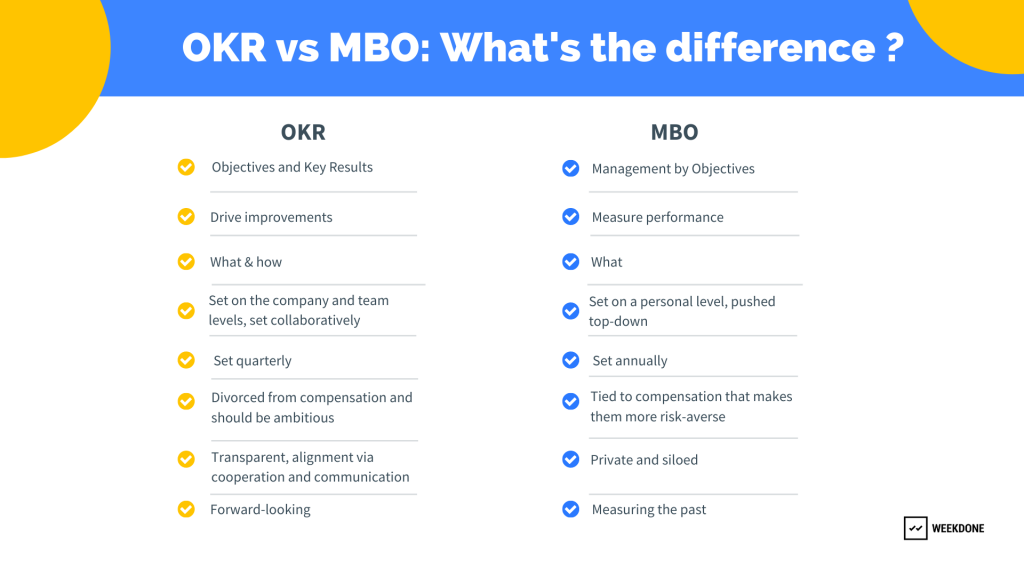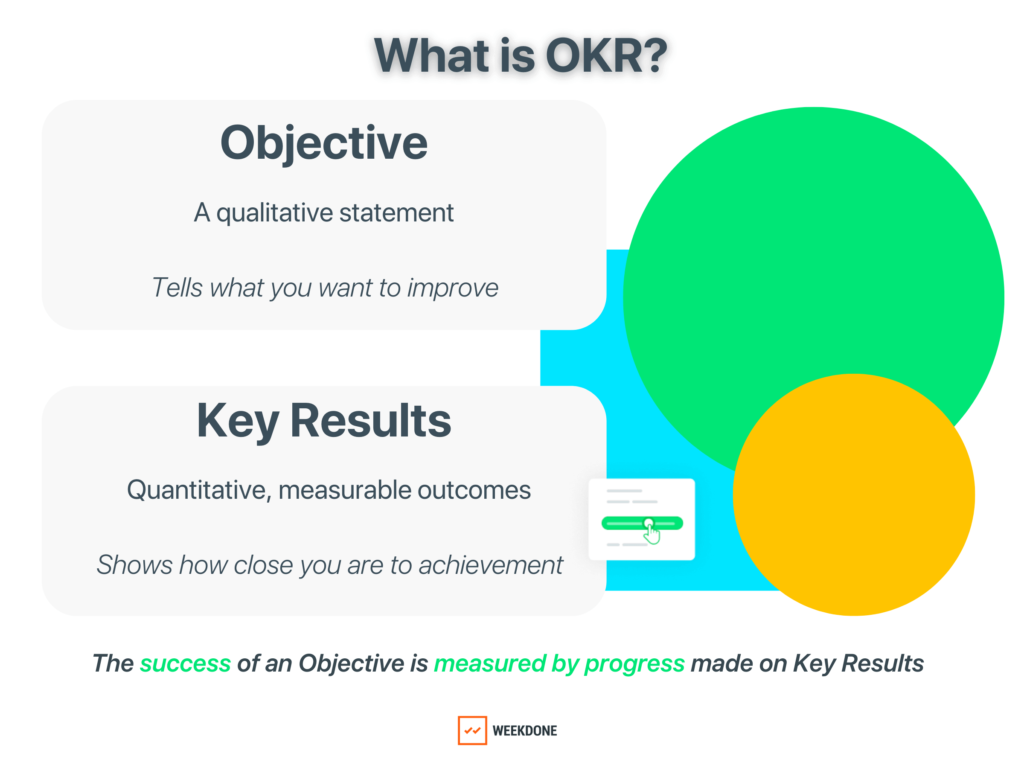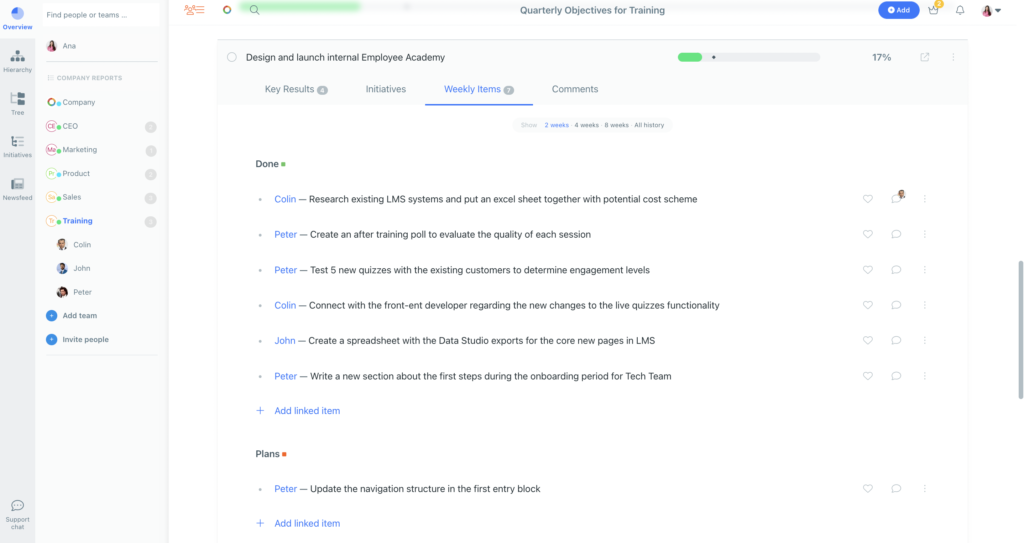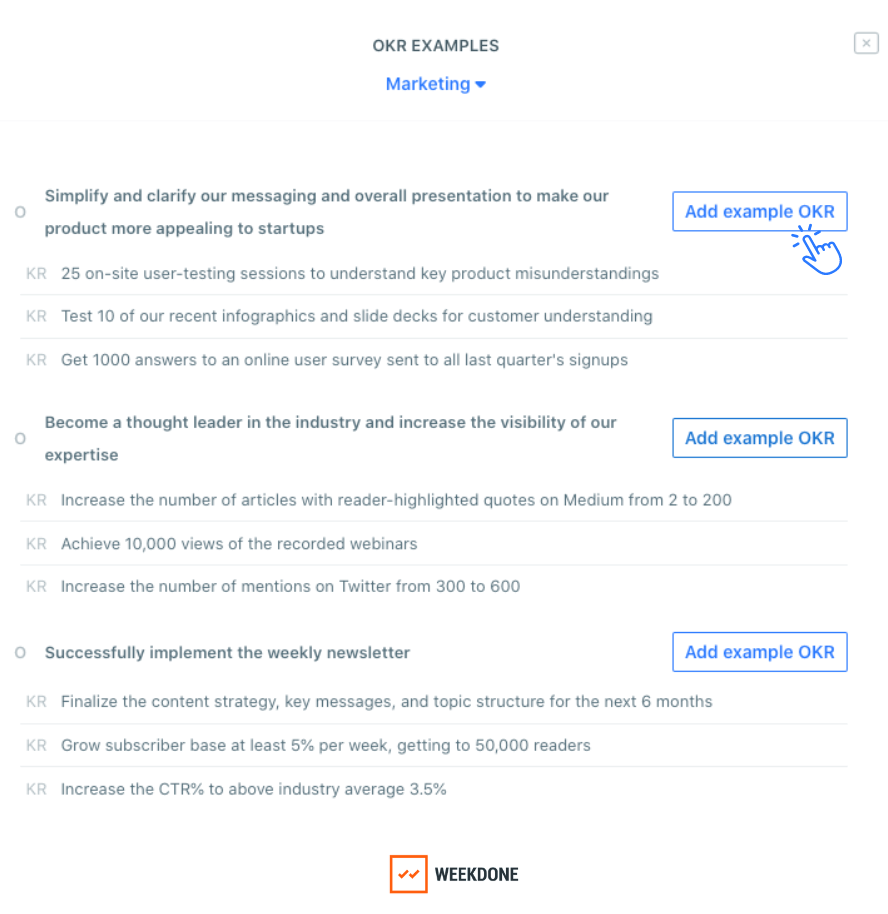In this article, we are reviewing two similar goal-setting frameworks: OKRs vs MBOs;
- Management by Objectives (MBO)
- Objectives and Key Results (OKR)
The difference between OKRs and MBOs is the purpose and desired value of the goal-setting process. However, both frameworks are aimed at setting and communicating strategic goals and measuring performance.
Setting goals remains one of the greatest challenges to executing a company’s strategy. According to HBR’s survey, team managers fail to achieve company targets because it’s either difficult to coordinate goals across units (30%) or align teams (40%).
The success of setting and achieving goals depends on the company culture and the suitable management style.
Read on to compare OKRs vs MBOs and choose the right goal management approach for your team.

What are MBOs?
The MBO meaning is Management by Objectives.
MBOs purpose is to imrove organizational performance by defining specific and clear Objectives for each employee and making them work towards the company’s goals.
For example, a sales manager can have a specific sales target that is agreed with the management. Once the sales team reaches this set revenue target, the managers and possibly the employees get an annual bonus.
The Objectives within MBO are set on the annual time horizon and based on certain alignment with company strategic goals. The Objectives set should follow the SMART (specific, measurable, achievable, realistic, and time-bound) principles.
MBO examples
To help you get a hang of what MBO approach looks like, we’ve provided some MBO examples for different teams below.
See which MBOs you can set up for your teams to drive the company’s growth.
Marketing MBO examples
- Generate 2,0000 MQLs this year from organic search
- Increase social referral traffic by 30%
- Increase landing page conversion rates by 40%
- Double newsletter subscriptions
- Increase marketing ROI by 10.5%
Sales MBO examples
- Drive-up MRR to $50,000
- Grow sales in Asia to 2,000 this year
- Hit the win rate of 20%
- Achieve an average deal size of $100,000
- Decrease sales cycle to 2 months
Customer Service MBO examples
- Reduce bounce rate after onboarding to 20%
- Achieve 8.0 Net Promoter Score (NPS)
- Increase customer references of qualified leads by 50%
- Collaborate with sales department to increase upselling by 10%
- Increase Customer LTV to 2 years
Product Management MBO examples
- Successfully launch 30 features this year
- Maintain 85% CSAT score
- Increase Daily Active User (DAU) to 1,000
- Decrease customer churn rate to 7%
What are OKRs?
OKRs stand for Objectives and Key Results.

Like MBO, the OKR approach is also about goal setting. However, if the purpose of MBOs is to simply measure organizational performance based on the individual level, OKRs’ goal is to drive improvement on the team level and measure how the team has been progressing towards common goals. While helping teams to improve certain areas, OKRs are also a good way to track progress, create team alignment, and encourage engagement around measurable goals.
OKRs are mostly set quarterly on company and team levels. OKRs are meant to be ambitious, inspirational, and, in most cases, achieving an OKR requires thinking outside of the box, trying new things, taking risks. And that is why OKRs are always divorced from compensation.
Ready for OKRs?
Speed up the OKR implementation and learning process with Weekdone, thanks to visual dashboards, intuitive reports. Plus, gain direct and unlimited OKR coaching for you and your team as needed.
OKR examples
Notice how OKRs for each team do not only specify what needs to be done (the Objective) but also tells how it can be achieved (the Key Results).
Marketing OKR
Objective: Improve our blog execution
Key Results:
- Publish 5 new blog posts to drive 3500 unique visitors
- Increase readers who open 2 or more blog articles from 100 to 200
- Increase subscribers from 3000 to 5000
Sales OKR
Objective: Grow our sales in Asia
Key Results:
- Increase MQL from Asia from 200 to 400
- Improve the sales process in Asia to increase SQL to Win in Asia from 25 to 35%
- Increase personal contact ratio from 50 to 75% of SQLs in Asia
Customer Service OKR
Objective: Increase engagement with new paying customers
Key Results:
- Increase the open rate of our in-product communications from 4% to 15%
- Increase the number of follow-up meetings booked from 7 to 21 per week
- Reduce average response time from 5h to 1h
Product Management OKR
Objective: Successfully launch version 3 of our main product
Key Results:
- Get over 10000 new signups
- Increase sign-up to trial ratio from 10% to 25%
- Increase trial to paid ratio from 30% to 50%
👉 Take a look at over 100+ OKR examples to get inspired and write your own!
Ready for OKRs?
Speed up the OKR implementation and learning process with Weekdone, thanks to visual dashboards, intuitive reports. Plus, gain direct and unlimited OKR coaching for you and your team as needed.
OKRs vs MBOs Differences
MBO is a famous approach and it might work for some organizations. This methodology has been around since the dawn of performance management. However, the OKR framework makes the goal-setting process much more engaging for business teams since they align their Objectives with the company’s bigger picture directions.
OKRs are meant for teams and organizations to facilitate growth, improvement, and innovation while MBO helps evaluate personal performance.
OKR is an outcome-driven framework that guides organizations to think about the results they really need to achieve where MBO is typically focused on a higher-level ambition.
Let’s take a closer look at what sets OKRs and MBOs apart:
1. Scope
MBO sets out what you want to accomplish. It measures how each individual performs against the goal they set up with their managers. It’s mostly focused on the final result without well-defined steps to achieve it.
OKR, on the other hand, sets out the what and how. The Objective outlines what needs to be improved, and the Key Results get into how this Objective can be driven. The OKR approach focuses on the improvement areas, not performance management.
2. Goal types
MBO is naturally risk-averse and pragmatic. This is partly due to the MBOs being tied to compensation when employees get their bonuses reduced in case they don’t achieve the Objectives fully. Therefore, people tend to set up ‘safe’ Objectives and be sure they fulfill them.
Whereas OKRs tend to be more aggressive and aspirational. Having Objectives that are transparent and collectively committed, it’s easier to tolerate failure. So getting only to the 60-70% of your ambitious Key Result already represents a great achievement, and the rest of it encourages innovation as consistently achieving 100% of your Objectives means you’re not being challenged.
Ready for OKRs?
Speed up the OKR implementation and learning process with Weekdone, thanks to visual dashboards, intuitive reports. Plus, gain direct and unlimited OKR coaching for you and your team as needed.
3. Timeline
Companies that use MBO-style management review performance annually. Objectives are set at the beginning of the year and then evaluated at the end. Goals tend to be broad and strategic versus focused and tactical.
OKRs operate under the premise that goals need reviewing a lot more frequently. Instead, they are set quarterly and reviewed and updated every week during the Team OKR check-in. It allows an organization to take impactful opportunities and make decisions based on current information rather than wait an entire year to address important issues.

👉 The best way to introduce weekly planning with your team is to use OKR software like Weekdone. It puts the idea of weekly check-ins in focus and builds a culture around regular updates and OKR tracking.
4. Evaluation
MBO evaluation and scores are a mix of “what I am going to do” and “how I am going to be evaluated”. This measurement is narrowly focused on a particular individual and prioritizes output (how much effort was produced) rather than outcome (how did this effort impact the business).
With OKRs, the Key Results are always quantitative and focusing on measurable outcomes. With Key Results, you will prove if your Objective was achieved or not. OKRs focus on results (outcomes) and not on the activities (outputs). Read more about the difference between outcomes vs outputs.
5. Levels
MBOs are assigned to individuals and agreed privately between an employee and their manager. All goals are confidential and the manager does not share them with the rest of the team. This confidentiality is required because MBO is linked to compensation (which we’ll get to below).
OKRs are much more transparent and team-focused where the Key Results are set up via team discussion and shared among teams. That means teams can be better aligned with each other because at the end of the day they are all trying to achieve the same things. Each team just contributes from their angle based on their expertise. Company Objectives set the direction for everyone.
6. Compensation
MBO sets the stage for determining an employee’s level of compensation based on the annual performance review model. Goals like this always focus on individual performance and their progress is evaluated based on the targets set for the employee at the beginning of the year.
OKRs should never be tied to compensation. Otherwise, people would fall back into their comfort zone and set less ambitious goals to make sure they can definitely achieve them. This goes against the whole point of OKRs.
Ready for OKRs?
Speed up the OKR implementation and learning process with Weekdone, thanks to visual dashboards, intuitive reports. Plus, gain direct and unlimited OKR coaching for you and your team as needed.
Final Thoughts
Goal-setting and strategic planning in organizations has been one of the most important, yet challenging areas.
Different companies choose different goal-setting techniques depending on the organization structure and management style.
In this article, we’ve compared two goal-setting frameworks OKR vs MBO to show how each management approach can move your company towards its goals.
While MBO approach just sets expectations but doesn’t directly help the company drive improvements, OKR methodology is a problem-solving approach that helps the company improve and grow by addressing its challenges or maximizing opportunities. MBOs rather create individualism as everyone is prioritizing their own goals whereas OKRs are a good seed for great teamwork, engagement and alignment.
